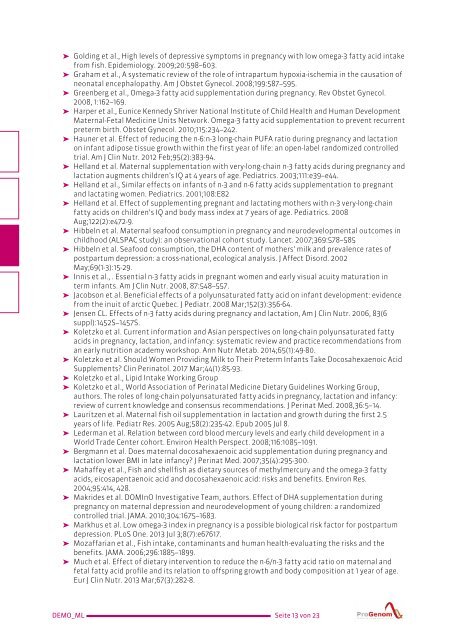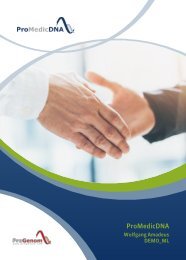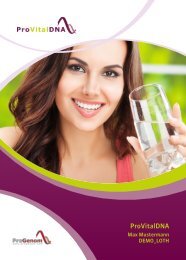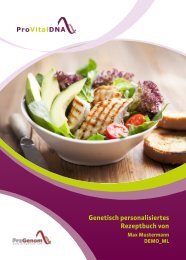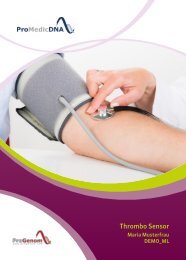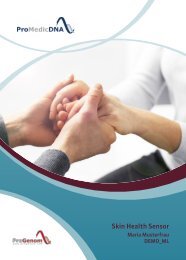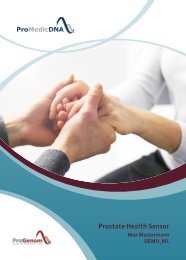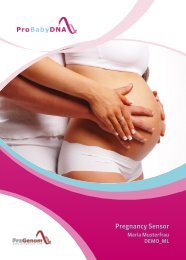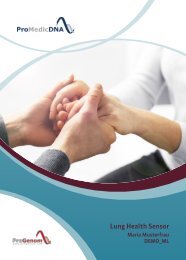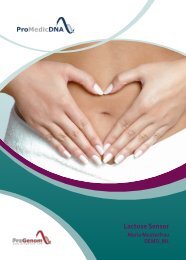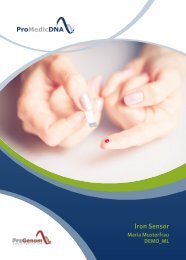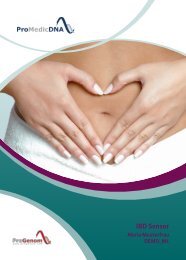Baby Breast Milk Sensor DEMO DE
nicht medizinische Analyse - ProBabyDNA medizinische Analyse (Schweiz)
nicht medizinische Analyse - ProBabyDNA
medizinische Analyse (Schweiz)
Create successful ePaper yourself
Turn your PDF publications into a flip-book with our unique Google optimized e-Paper software.
➤ Golding et al., High levels of depressive symptoms in pregnancy with low omega-3 fatty acid intake<br />
from fish. Epidemiology. 2009;20:598–603.<br />
➤ Graham et al., A systematic review of the role of intrapartum hypoxia-ischemia in the causation of<br />
neonatal encephalopathy. Am J Obstet Gynecol. 2008;199:587–595.<br />
➤ Greenberg et al., Omega-3 fatty acid supplementation during pregnancy. Rev Obstet Gynecol.<br />
2008, 1:162–169.<br />
➤ Harper et al., Eunice Kennedy Shriver National Institute of Child Health and Human Development<br />
Maternal-Fetal Medicine Units Network. Omega-3 fatty acid supplementation to prevent recurrent<br />
preterm birth. Obstet Gynecol. 2010;115:234–242.<br />
➤ Hauner et al. Effect of reducing the n-6:n-3 long-chain PUFA ratio during pregnancy and lactation<br />
on infant adipose tissue growth within the first year of life: an open-label randomized controlled<br />
trial. Am J Clin Nutr. 2012 Feb;95(2):383-94.<br />
➤ Helland et al. Maternal supplementation with very-long-chain n-3 fatty acids during pregnancy and<br />
lactation augments children’s IQ at 4 years of age. Pediatrics. 2003;111:e39–e44.<br />
➤ Helland et al., Similar effects on infants of n-3 and n-6 fatty acids supplementation to pregnant<br />
and lactating women. Pediatrics. 2001;108:E82<br />
➤ Helland et al. Effect of supplementing pregnant and lactating mothers with n-3 very-long-chain<br />
fatty acids on children's IQ and body mass index at 7 years of age. Pediatrics. 2008<br />
Aug;122(2):e472-9.<br />
➤ Hibbeln et al. Maternal seafood consumption in pregnancy and neurodevelopmental outcomes in<br />
childhood (ALSPAC study): an observational cohort study. Lancet. 2007;369:578–585<br />
➤ Hibbeln et al. Seafood consumption, the DHA content of mothers' milk and prevalence rates of<br />
postpartum depression: a cross-national, ecological analysis. J Affect Disord. 2002<br />
May;69(1-3):15-29.<br />
➤ Innis et al., . Essential n-3 fatty acids in pregnant women and early visual acuity maturation in<br />
term infants. Am J Clin Nutr. 2008, 87:548–557.<br />
➤ Jacobson et al. Beneficial effects of a polyunsaturated fatty acid on infant development: evidence<br />
from the inuit of arctic Quebec. J Pediatr. 2008 Mar;152(3):356-64.<br />
➤ Jensen CL. Effects of n-3 fatty acids during pregnancy and lactation, Am J Clin Nutr. 2006, 83(6<br />
suppl):1452S–1457S.<br />
➤ Koletzko et al. Current information and Asian perspectives on long-chain polyunsaturated fatty<br />
acids in pregnancy, lactation, and infancy: systematic review and practice recommendations from<br />
an early nutrition academy workshop. Ann Nutr Metab. 2014;65(1):49-80.<br />
➤ Koletzko et al. Should Women Providing <strong>Milk</strong> to Their Preterm Infants Take Docosahexaenoic Acid<br />
Supplements? Clin Perinatol. 2017 Mar;44(1):85-93.<br />
➤ Koletzko et al., Lipid Intake Working Group<br />
➤ Koletzko et al., World Association of Perinatal Medicine Dietary Guidelines Working Group,<br />
authors. The roles of long-chain polyunsaturated fatty acids in pregnancy, lactation and infancy:<br />
review of current knowledge and consensus recommendations. J Perinat Med. 2008,36:5–14.<br />
➤ Lauritzen et al. Maternal fish oil supplementation in lactation and growth during the first 2.5<br />
years of life. Pediatr Res. 2005 Aug;58(2):235-42. Epub 2005 Jul 8.<br />
➤ Lederman et al. Relation between cord blood mercury levels and early child development in a<br />
World Trade Center cohort. Environ Health Perspect. 2008;116:1085–1091.<br />
➤ Bergmann et al. Does maternal docosahexaenoic acid supplementation during pregnancy and<br />
lactation lower BMI in late infancy? J Perinat Med. 2007;35(4):295-300.<br />
➤ Mahaffey et al., Fish and shellfish as dietary sources of methylmercury and the omega-3 fatty<br />
acids, eicosapentaenoic acid and docosahexaenoic acid: risks and benefits. Environ Res.<br />
2004;95:414, 428.<br />
➤ Makrides et al. DOMInO Investigative Team, authors. Effect of DHA supplementation during<br />
pregnancy on maternal depression and neurodevelopment of young children: a randomized<br />
controlled trial. JAMA. 2010;304:1675–1683.<br />
➤ Markhus et al. Low omega-3 index in pregnancy is a possible biological risk factor for postpartum<br />
depression. PLoS One. 2013 Jul 3;8(7):e67617.<br />
➤ Mozaffarian et al., Fish intake, contaminants and human health-evaluating the risks and the<br />
benefits. JAMA. 2006;296:1885–1899.<br />
➤ Much et al. Effect of dietary intervention to reduce the n-6/n-3 fatty acid ratio on maternal and<br />
fetal fatty acid profile and its relation to offspring growth and body composition at 1 year of age.<br />
Eur J Clin Nutr. 2013 Mar;67(3):282-8.<br />
<strong><strong>DE</strong>MO</strong>_ML Seite 13 von 23


